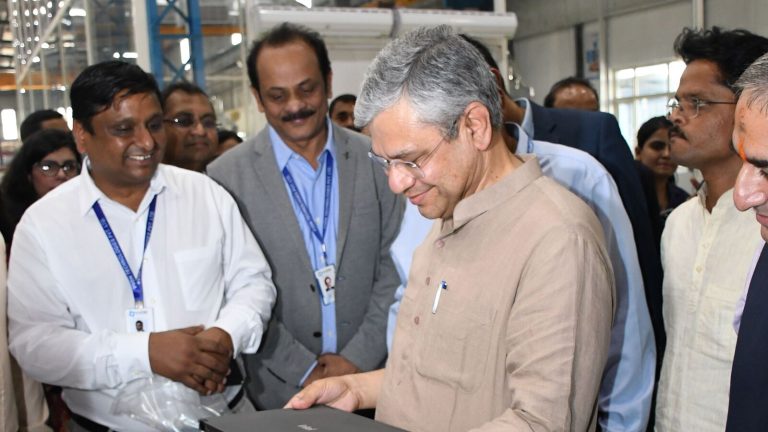The new facilities, coupled with VVDN’s in-house designing capability, will make this the first time that more than 50% of the cost of making a laptop will contribute to revenue generated from India.
In an interview with Mint, Puneet Agarwal, chief executive of VVDN Technologies, said that with its new local manufacturing efforts, the company is already seeing 40% of the cost of making a laptop contributing to domestic revenue. “All of these efforts contribute towards adding 10-40% to domestic value addition. We are already rolling out laptops from our assembly line, where 40% of the revenue accounts for domestic value addition,” he said.
“We are also a design-led manufacturer, and all our product reference designs are in-house. If we take the design aspect into account, the domestic value that we are adding to telecom equipment and laptops goes well above 50%,” Agarwal added.
Domestic value addition refers to the net revenue generated from operations within a country without depending on imports. This includes manufacturing components, sourcing raw materials, making equipment for the manufacturing process, and designing the device being made.
VVDN’s announcement on Friday is the first one after the Centre approved a $2.7-billion components incentive scheme on 28 March, where the Union government will offer up to 10% turnover-linked incentive and up to 25% capital expenditure-based incentive to electronics firms that build devices, components and specialized manufacturing equipment in India.
Union IT minister Ashwini Vaishnaw, who inaugurated VVDN’s assembly line on Friday, said the move can “give us a big advantage compared to many other countries, which don’t have this much design talent.”
Reaping dividends
VVDN, on this note, will be an applicant to the Centre’s components incentive scheme to maximize cash flow and broaden its operating margin.
“Electronics manufacturing is today employing about 2.5 million people, handling some of the most complex equipment. The sector has increased 5x in the past 10 years. Today, the sector has topped $130 billion. Electronics exports have increased 6x in the past 10 years, nearing $40 billion,” Vaishnaw said.
VVDN, Vaishnaw added, has over 5,000 design engineers in the country—“taking a big leap from the legacy systems and designing products where AI is embedded in the product itself.”
The move is helping firms such as VVDN Technologies already reap dividends. Agarwal told Mint that the company “is already cash-flow positive, and has strong growth opportunities going forward.”
The company’s financial filing with the Registrar of Companies (RoC), accessed by Mint, said it crossed $250 million in annual revenue in FY24. Agarwal did not offer a revenue projection for the previous fiscal, i.e. FY25. But, the executive said that based on its anticipated order book and expansion of capabilities, VVDN Technologies is not in the market for a private equity or venture capital funding round, or a public listing this fiscal year.
“We may consider plans for a public listing multiple years down the line, but at least for now, we don’t have any fundraising plan in mind,” Agarwal said.
Earlier this month, VVDN Technologies rolled out locally-made laptops for the Taiwanese electronics conglomerate brand, Asus. The company currently has an assembly line capacity of producing 20,000 laptops per month from its Manesar plant, which Agarwal said can be ramped up to 100,000 units monthly, depending on demand.
Dependence on other nations
Beyond devices, the production facility also focuses on components such as printed circuit boards (PCBs), moulding—which is used to make the external casing on laptops and other devices, and tooling—or mechanical equipment used to manufacture these components.
In each of these, most raw materials and core components are already being sourced from within India itself, Agarwal said. “In areas such as the making of device moulds, most of the operation is sourced through supply chain entities in India itself. In electronic devices such as network switches and routers, core electronics components are still imported from various nations—which we are working on reducing in the long run,” he added.
Industry experts have repeatedly highlighted India’s dependence on nations such as China for core electronics and networking components, and critical raw material such as processed metals for networking hardware and battery cells, as the key roadblock for India’s electronics economy. Targets set by the Centre have sought to make electronics a $500 billion annual revenue generator by 2030.
On 10 April, Mint reported that India’s electronics exports could comfortably cross $50 billion in the next five years. Crucially, industry analysts have said that alongside ramping up annual revenue, India’s key goal is to increase domestic value addition of electronics and related equipment and components—which is estimated to be between 10-20% for now.
“The Centre is looking to incentivize ways for private firms to expand domestic value addition significantly by focusing on local design capability, since India has a lot of design engineering talent. Through incentives, India can draw global supply chain entities to the country, and the current geopolitics can push India to become a more important part of a distributed supply chain away from China,” said Ashok Chandak, president of the industry body, India Electronics and Semiconductor Association (Iesa).
Mint further reported on 16 April that the Centre is also looking to roll out a broad-based design-linked incentive scheme as part of its overhaul of the India Semiconductor Mission. Such a move will further bode well for VVDN Technologies, which is already designing devices and manufacturing components locally to add increasing value to the Indian electronics supply chain.


